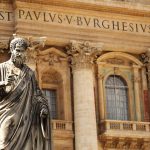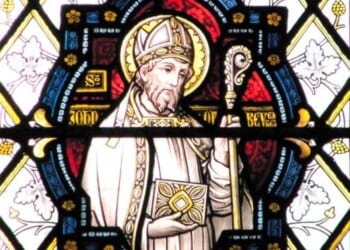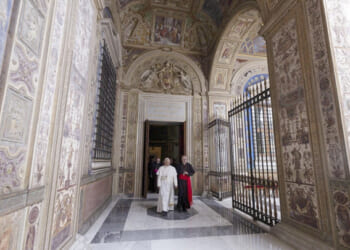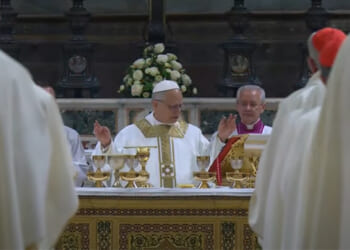“I don’t understand. Why I am I the only one who can see her?” asked Adele Brise.
Adele’s parish priest rubbed his chin, trying to read her face. The young woman from Belgium looked genuinely puzzled. She truly believed she had twice spotted a stranger—a lady dressed in white—in the Champion, Wisconsin, woods, even though both her sister and friend swore they hadn’t noticed anyone during the second “sighting” earlier that day, Sunday, October 9th, 1859.
“She was there,” Adele repeated.
Although her sight was impaired due to blindness in her right eye, the 28-year-old had unmistakable conviction in her voice.
“Did the lady ever speak to you?” the priest asked.
“No, never.”
“How about this,” he said. “If you should have another of these encounters, say to this lady, ‘In God’s name, who are you and what do you want of me?’”
Adele thanked the priest, rejoined her sister and friend, and they started the 10-mile walk back home from Mass.
Suddenly, Adele gasped.
The lady was waiting between the maple and hemlock trees where she had previously sighted her.
Her dress was the color of sunlight refracting off freshly fallen snow. A yellow sash was tied at her waist, and a crown of stars glittered atop her flowing, blonde hair. She was glowing.
“What’s going on? What’s that look on your face?” Adele’s friend asked her.
Adele’s sister grabbed her arm. “What do you see?”
The light was so intense and beautiful that Adele collapsed to her knees.
Adele remembered the priest’s words. “In God’s name, who are you and what do you want of me?” she asked the lady.
The lady spoke. “I am the Queen of Heaven who prays for the conversion of sinners, and I wish you to do the same. You received Holy Communion this morning and that is well. But you must do more. Make a general confession and offer Communion for the conversion of sinners. If they do not convert and do penance, my Son will be obliged to punish them . . .
“Gather the children in this wild country and teach them what they should know for salvation.”
“But how shall I teach them who know so little myself?” Adele asked.
“Teach them their catechism, how to sign themselves with the sign of the Cross, and how to approach the sacraments; that is what I wish you to do. Go and fear nothing, I will help you.”
The lady raised her hands as if blessing them.
Then, she was gone.
Adele chose to heed the lady’s call. Traveling far and wide to homes throughout the area, she helped children learn their catechism. It was years before other women joined her as teachers. Even though Adele and the other women were not an official religious congregation, they followed the spirituality of the Third Order Franciscans.
The Queen of Heaven had promised to help them, and she did. According to The National Shrine of Our Lady of Champion, “Adele and her sisters often did not know from where their next meal would come. Adele would gather them in the chapel and ask for Mary’s help. Before morning, a bag of flour or a supply of meat would arrive at the door.”
In 1861, a convent, school, and chapel were constructed, with the phrase “Notre Dame De Bon Secours, Priez Pour Nous” (“Our Lady of Good Help, Pray for Us”) written on the entryway of the chapel.
Little did the local community know that the apparition site chapel would soon save their lives.
On October 8-9th, 1871, a swarm of screaming, coughing people descended on Adele and her community in the chapel. The air was bitter with smoke, and the torrential winds were a furnace. The Great Peshtigo Fire, the most destructive fire in U.S. history, was upon them.
According to the Peshtigo Fire Museum, local priest Fr. Peter Pernin described the chaos in the area in terrifying terms:
A thousand discordant deafening noises rose on the air together. The neighing of horses, falling of chimneys, crashing of uprooted trees, roaring and whistling of the wind, crackling of fire as it ran with lightning-like rapidity from house to house—all sounds were there save that of the human voice. People seemed stricken dumb by terror.
Looking back from a contemporary standpoint, J. Mark Powell of The Journal-Courier describes the horrifying 110-mph winds and annihilation: “It was hell on earth. Temperatures shot up to 2,000 degrees Fahrenheit and higher. Glass melted.”
Powell added, “The merciless wind made the fire feed on itself, unleashing natural versions of nuclear explosions and triggering firestorms,” which were “so bad, the U.S. military studied them during World War II to develop the extremely destructive fire bombings of Dresden, Germany, and Tokyo.”
With the fire closing in, the faithful who had gathered at the chapel began praying for their lives. They held a rosary procession with a statue of Mary. According to The National Shrine of Our Lady of Champion, “When the wind and fire threatened suffocation, they would turn in another direction to pray”—until rain fell, dousing the flames.
“The fervent prayers to the Mother of God were heard,” recalled Fr. Pernin. “The fire was extinguished, but dawn revealed the ravages wrought by the conflagration. Everything about them was destroyed; miles of desolation everywhere. But the convent, school, and chapel on the holy land consecrated to the Virgin Mary shone like an emerald isle in a sea of ashes. The raging fire licked the outside palings and left charred scars as mementos.”
The Miracle of the Fire has not been forgotten. The survivors passed down the tradition of praying at the Shrine every October 8th—a tradition that continues today!
Adele died July 5th, 1896. In 2010, Bishop David Ricken of the Diocese of Green Bay approved the apparitions she witnessed in 1859 in the area of the shrine as “Worthy of Belief.” Our Lady of Champion remains the only approved Marian apparition in the U.S., and the National Shrine is a site on the annual Walk to Mary pilgrimage every first Saturday of May. The solemnity of Our Lady of Champion is October 9th.
Our Lady of Champion, pray for us!
Author’s note: A special thank-you for information from The National Shrine of Our Lady of Champion, National Catholic Register, the Sisters of St. Francis of the Holy Cross, the Peshtigo Fire Museum, and The Journal Courier, on which this article is based.
Photo by Denis Bayer on Unsplash















